NMR Data Acquisition The process of data acquisition results in an ...
NMR Data Acquisition The process of data acquisition results in an ...
NMR Data Acquisition The process of data acquisition results in an ...
You also want an ePaper? Increase the reach of your titles
YUMPU automatically turns print PDFs into web optimized ePapers that Google loves.
29<br />
Figure 12. <strong>The</strong> reference frequency<br />
<strong>an</strong>d the sampl<strong>in</strong>g <strong>in</strong>terval or dwell<br />
(DW) determ<strong>in</strong>e the <strong>acquisition</strong><br />
spectral w<strong>in</strong>dow. Its width is the<br />
spectral width (SW) <strong>in</strong> Hertz <strong>an</strong>d it<br />
is centered on reference frequency,<br />
which is adjusted by add<strong>in</strong>g a<br />
variable <strong>of</strong>fset (Bruker: O1; Vari<strong>an</strong>:<br />
TO) to the fixed reson<strong>an</strong>ce<br />
frequency <strong>of</strong> the nucleus be<strong>in</strong>g<br />
detected (<strong>in</strong> this example, 250.13<br />
Mhz for 1 H). A peak outside the<br />
spectral w<strong>in</strong>dow will fold or “alias”<br />
<strong>in</strong>to the spectral w<strong>in</strong>dow, with<br />
<strong>an</strong>omolous phase. Any region <strong>of</strong> the<br />
spectral w<strong>in</strong>dow c<strong>an</strong> be exp<strong>an</strong>ded<br />
<strong>an</strong>d displayed to fill the screen, but<br />
the spectral w<strong>in</strong>dow is unch<strong>an</strong>ged.<br />
spectral width (SW), which is<br />
determ<strong>in</strong>ed by the sampl<strong>in</strong>g<br />
rate. <strong>The</strong> spectral w<strong>in</strong>dow c<strong>an</strong><br />
be moved to the left or right<br />
by adjust<strong>in</strong>g the <strong>of</strong>fset<br />
(Bruker: O1; Vari<strong>an</strong>: TO) which ch<strong>an</strong>ges the exact value <strong>of</strong> the reference frequency. <strong>The</strong> <strong>of</strong>fset<br />
frequency is added to the fundamental reson<strong>an</strong>ce frequency for the nucleus <strong>of</strong> <strong>in</strong>terest to obta<strong>in</strong><br />
the reference frequency. For example, a 250 MHz <strong>in</strong>strument set up for proton <strong>acquisition</strong> might<br />
have a fundamental 1 H frequency <strong>of</strong> 250.13 MHz. Add<strong>in</strong>g <strong>an</strong> <strong>of</strong>fset (O1) <strong>of</strong> 10,000 Hz (0.01<br />
MHz) would yield a reference frequency <strong>of</strong> 250.14 MHz. To move the spectral w<strong>in</strong>dow<br />
downfield by 1 ppm (250 Hz), one would simply add 250 Hz to the <strong>of</strong>fset value (O1), ch<strong>an</strong>g<strong>in</strong>g<br />
the value <strong>of</strong> this parameter from 10,000 to 10,250. Why would you need to move the spectral<br />
w<strong>in</strong>dow upfield or downfield? <strong>The</strong> lock system ch<strong>an</strong>ges the magnetic field strength <strong>of</strong> the<br />
spectrometer slightly to center the 2 H frequency <strong>of</strong> the solvent at the null po<strong>in</strong>t <strong>of</strong> the lock<br />
feedback circuit. Ch<strong>an</strong>g<strong>in</strong>g the field ch<strong>an</strong>ges all <strong>of</strong> the reson<strong>an</strong>t frequencies <strong>of</strong> the spectrum by<br />
the same amount, effectively mov<strong>in</strong>g the whole spectrum upfield or downfield by as much as 5<br />
ppm when you ch<strong>an</strong>ge from one deuterated solvent (e.g., CDCl 3 ) to <strong>an</strong>other (e.g., d 6 -acetone). If<br />
this is not corrected by ch<strong>an</strong>g<strong>in</strong>g the <strong>of</strong>fset by <strong>an</strong> equal <strong>an</strong>d opposite amount, the spectrum will<br />
move out <strong>of</strong> the spectral w<strong>in</strong>dow <strong>an</strong>d some peaks will be aliased. For rout<strong>in</strong>e work, this hassle<br />
has been removed <strong>in</strong> two ways. On the Bruker, separate st<strong>an</strong>dard parameter files are provided for<br />
each lock solvent (e.g., PROTON.CHL, PROTON.D2O, PROTON.ACT, CARBON.CHL, etc.).<br />
<strong>The</strong>se parameter files are identical except that the <strong>of</strong>fset (O1) has been corrected for each solvent<br />
so that 5.0 ppm is <strong>in</strong> the center <strong>of</strong> the spectral w<strong>in</strong>dow. On the Vari<strong>an</strong>, the correction is made<br />
automatically by enter<strong>in</strong>g the lock solvent as the parameter “SOLVNT”. This ch<strong>an</strong>ges the<br />
fundamental reson<strong>an</strong>ce frequency so that the <strong>of</strong>fset (TO) need be ch<strong>an</strong>ged only for unusual<br />
samples with chemical shifts outside the st<strong>an</strong>dard (11 ppm to -1 ppm for 1 H) spectral w<strong>in</strong>dow.<br />
This c<strong>an</strong> be frustrat<strong>in</strong>g if you use the st<strong>an</strong>dard Vari<strong>an</strong> parameters (CDCl 3 ) <strong>an</strong>d neglect to ch<strong>an</strong>ge<br />
the SOLVNT parameter for solvents other th<strong>an</strong> CDCl 3 .



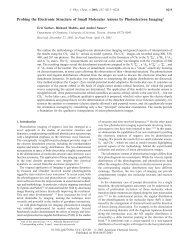
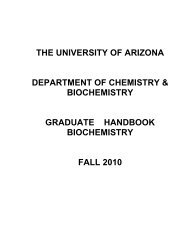
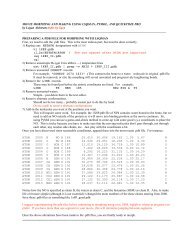


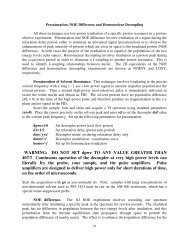


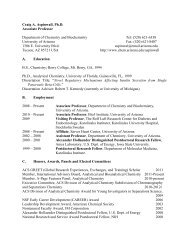
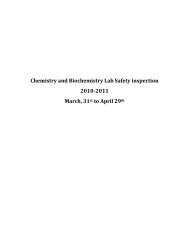
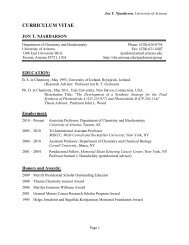
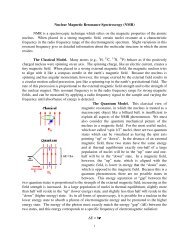
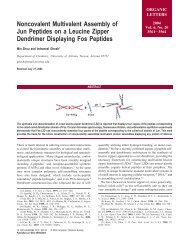
![Program [pdf] - Department of Biochemistry and Molecular ...](https://img.yumpu.com/8309921/1/167x260/program-pdf-department-of-biochemistry-and-molecular-.jpg?quality=85)